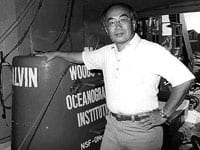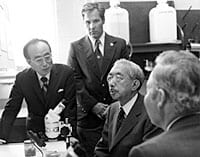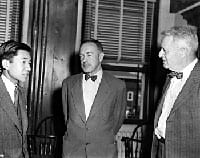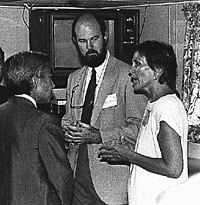WHOI Scientist Honored by Japanese Government
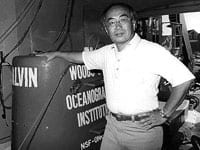
May 1, 2003
One of Japan’s highest honors, the Imperial Order of the Rising Sun, will be bestowed on Dr. Susumu Honjo of the Woods Hole Oceanographic Institution (WHOI) for his research on the transfer of carbon dioxide from the atmosphere to the ocean’s interior and for his efforts to strengthen Japan’s role in the international ocean science research community. Honjo, the first oceanographer to be presented with this honor, will accept the award May 12 from Emperor Akihito in ceremonies at the Imperial Palace in Japan.
“Dr. Honjo has been closely associated with Japanese ocean science as a reliable adviser, an enthusiastic participant and a strong leader,” says the award nomination. “His activity clearly has strengthened Japan’s presence internationally in the field of ocean science. He has been not only a highly significant global leader on a new and critical field of ocean science, but has made clear and strong contributions to Japanese oceanography.”
The Order of the Rising Sun was established in 1875 by Emperor Meiji to be conferred upon men who had rendered distinguished service to the nation and people of Japan. There are various classes of the award; Honjo will receive the Order of the Rising Sun, Gold Rays with Neck Ribbon (a medal with ribbon), which is one of the highest honors given to citizens of another nation. The awards are announced twice a year, on April 29 and November 3, and are administered by the Prime Minister’s Office.
Since the 1970s, Honjo has conducted experiments around the world to better understand the process, rates and the volume of the transfer of carbon dioxide (CO2) from the atmosphere to the ocean’s interior and sea floor. He successfully demonstrated that excess atmospheric CO2 is removed by particles of organic carbon, commonly called marine snow, that pass from surface waters to the ocean floor.
Honjo is a founder of the International Joint Global Ocean Flux Study (JGOFS) established in 1983 to understand the ocean carbon cycle, collecting data through sediment traps at 166 sites in all the major ocean basins of the world, and has developed new instrumentation to realistically estimate the rate and volume of CO2 transport to the ocean interior. Many consider him the founder of biogeochemical times-series instrumentation methodology, one of the most hopeful tools in this decade to further understand the changes in the earth¹s environment.
In April 2000 the Japan Marine Science and Technology Center (JAMSTEC) invited Honjo to be a part-time executive director of the organization, the first foreign executive director of a major government organization in Japan, enabling him to maintain his position as a Senior Scientist at WHOI. Through his position at JAMSTEC, Honjo has directed the establishment of a new ocean research institution, the Mutsu Institute for Oceanography, in Mutsu City, Japan, to maintain a decadal program to understand the role of the Northwest Pacific in CO2 cycles and productivity. He also serves as the first Director of the Joint North Pacific Research Center at WHOI, a collaborative effort between Mutsu Institute of Oceanography of JAMSTEC and WHOI.
Honjo is a senior scientist in the WHOI Geology and Geophysics Department. He was born in Japan, holds degrees in geological sciences from Hokkaido University, and has been a US citizen since 1978. Honjo joined the WHOI staff in 1970 as Associate Scientist and was promoted to Senior Scientist in 1982. He held the Institution¹s Columbus O¹Donnell Iselin Chair for Excellence in Oceanography from 1989 to 1994. He has been active in education and training programs, supervising many graduate students in the MIT/WHOI Joint Program in Oceanography and Applied Ocean Science and Engineering and postdoctoral investigators.
The Imperial family has a long relationship with the Woods Hole Oceanographic Institution. The late Emperor Hirohito visited Woods Hole and the Institution in 1975 to pursue his well-known interest in marine biology. Crown Prince Akihito, now Emperor Akihito, also has a strong interest in marine biology and visited the Institution in 1953. He maintained that long relationship when he visited the Institution’s Research Vessel Atlantis II and the three-person submersible Alvin during a port call in Tokyo in August 1987.
WHOI is a private, independent marine research and engineering, and higher education organization located in Falmouth, MA. Its primary mission is to understand the oceans and their interaction with the Earth as a whole, and to communicate a basic understanding of the ocean’s role in the changing global environment. Established in 1930 on a recommendation from the National Academy of Sciences, the Institution is organized into five departments, interdisciplinary institutes and a marine policy center, and conducts a joint graduate education program with the Massachusetts Institute of Technology.

